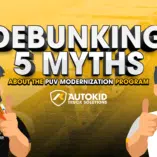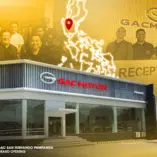The Philippines’ Public Utility Vehicle (PUV) Modernization Program is a large-scale initiative aiming to improve the country’s public transportation system. Its goals are to significantly improve road safety by replacing aging jeepneys with safer models, to reduce air pollution through stricter emission standards for new vehicles, and to enhance the overall commuter experience by introducing comfortable, efficient, and eco-friendly jeepneys.
Let’s clear up some common myths and provide facts from credible sources:
Myth 1: The PUV Modernization Program will completely replace all existing jeepneys
Our country is known for its quirky jeepney designs. This program created a misconception that the Filipino trademark in public transportation will be replaced with modern and standard transportation designs. This misconception may have stemmed from a lack of clear communication about the program’s goals. While phasing out older models is crucial, the program emphasizes modernization, not eradication, of jeepneys.
FACT: According to the Department of Transportation, the program aims to modernize the jeepney fleet, not eliminate it. As prescribed by existing DOTr and LTFRB issuances, jeepneys and buses that are already more than 15 years old are not allowed to operate under this program because it aims to improve the transportation system with new jeepney models following stricter emissions standards and safety features. Transportation Secretary Jaime Bautista also claimed that the program does not aim to eliminate the iconic transport on the Philippine roads.
Myth 2: The modern jeepneys are too expensive for drivers and operators
This myth likely arises from concerns about the upfront cost of new jeepneys for drivers and operators. While government assistance exists, there might be anxieties about long-term loan repayments and the program’s affordability for smaller operators.
FACT: The government offers financial assistance programs to ease the transition. These include scrapping incentives for old jeepneys and loans for acquiring new units.
Cooperatives can thrive in the PUV modernization program by collaborating with relevant agencies to access a comprehensive support network. Financial assistance, like subsidies and low-interest loans, significantly reduces the upfront costs of acquiring new jeepneys. Livelihood grants can provide temporary financial support for drivers and operators during the transition period. Additionally, partnerships with local government units (LGUs), training programs, and ongoing business support services will equip cooperatives with the skills and resources needed for long-term success.
Myth 3: The new jeepneys are not suited for Filipino commuters
This myth might be due to a perception that modern jeepney designs don’t cater to Filipino commuters’ needs. The focus on designated seating might seem to disregard the traditional jeepney’s characteristic of accommodating passengers with bulky items.
FACT: According to the LTFRB website, modern jeepney designs prioritize passenger capacity and comfort. Features include designated seating areas, improved ventilation, and wider doors for easier entry and exit. Modern jeepneys can offer a safe, comfortable, and efficient experience for Filipino commuters while adapting to some aspects of the traditional system.
Myth 4: The PUV Modernization Program will solve traffic congestion
This misconception likely overlooks the program’s broader context. Modern jeepneys can improve traffic flow, but it’s not a standalone solution. Infrastructure improvements, route planning, and overall traffic management are necessary to truly address congestion.
FACT: According to a study by the Japan International Cooperation agency, while modern jeepneys may improve traffic flow to some extent, it’s not a standalone solution. The program needs to be complemented by investments in infrastructure, route planning, and traffic management to truly address congestion.
Myth 5: The program has no impact on pollution
This myth might stem from a lack of awareness about the stricter emission standards for modern jeepneys. Euro 4 or Euro 5 compliance significantly reduces pollution compared to older models, contributing to cleaner air.
FACT: Cited in a cost-benefit study published by Clear Air Asia, modern jeepneys adhere to stricter Euro 4 or Euro 5 emission standards, significantly reducing air pollution compared to older models. This can contribute to improved air quality in urban areas.
By understanding these myths and facts, Filipinos can engage in a more informed discussion about the PUV Modernization Program.
Remember, a successful program requires not just modern vehicles but also a holistic approach to public transportation that considers affordability, ridership needs, and long-term sustainability.
Angat ka with AUTOKID PUVMP!
We at Autokid are at the forefront of PUVMP solutions, aiming to contribute to a stronger public transport system by supplying Filipinos with proudly Filipino-made dependable and comfortable PUVs. We are also a one-stop-shop of all of your PUVMP needs offering a comprehensive range of:
Modern PUV Units: We provide a diverse selection of proudly Filipino-made PUV models that meet the latest government standards, ensuring safety, maximum comfort, and environmental friendliness.
Parts Availability: We offer a complete stock of high-quality parts specifically designed for modern PUVs, keeping your fleet running smoothly.
Expert After-Sales Support: Our dedicated team provides comprehensive after-sales service, from maintenance packages to technical assistance, guaranteeing peace of mind for your operations. We also have a dedicated after-sales call center team that fast tracks your inquiries and concerns.
Ready to embrace the future of public transportation?
For the latest updates and industry insights, follow us on Facebook at Autokid PUVMP Solutions
Together, let’s make the PUVMP a success story for Filipino commuters, operators, and the environment.












